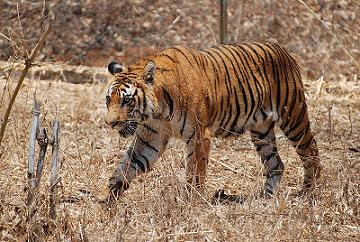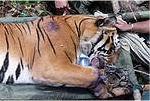Due to increased problems with poaching, the conservation organization TRAFFIC has joined with the National Tiger Conservation Authority (NTCA) to begin tracking every tiger mortality in India with a new website called Tigernet.
The website will also track tiger-related crimes, allowing wildlife wardens and field directors of Project Tiger Reserves to access key data on tiger death and crime in an instant, including seizures of tiger products.
Since the Bengal tiger (panthera tigris tigris) is a flagship species in India, the organizations say they hope the website will aid biodiversity overall in India by providing up-to-date information on wildlife criminals for whom tigers is just one of the more lucrative targets. For instance, the site is currently reporting the poaching of a leopard in Jammu and Kashmir.
 Bengal tiger in Karnataka, India. Photo by: Paul Mannix. |
The website also hopes to involve the public in reporting wildlife crimes by providing a place where citizens can send in their own reports.
According to a press release by TRAFFIC, “[the] collection of streamlined information is the first step toward addressing the root cause of a misdeed and this website has to be seen in this context. It is hoped that it will engender a spirit of honesty and cooperation among all major stakeholders in Tiger conservation in the country for remedial action to save the majestic predator of the Indian jungles along with all the other denizens that cohabit with this species.”
India has been seen as one of the very few bright spots in tiger conservation. However, in 2008 the nation downgraded its likely number of tigers from 3,508 to 1,411. Poaching continues to be a major problem for tigers not just in India but in every remaining habitat. The poaching is fueled by the black market in tiger parts, which are used in traditional Chinese medicines. While China has currently banned any selling of tiger parts, the ban has not stopped the underground trade. In a 2008 poll of Chinese residents in seven major cities, 43 percent admitted that they had consumed products that they thought contained tiger parts.
Three subspecies of tiger already vanished in the 20th Century: the Javan, the Balinese, and the Caspian tiger due to habitat loss and poaching. Six subspecies remain; two of which are considered Critically Endangered by the IUCN Red List: the South China Tiger (panthera tigris amoyensis) and the Sumatran Tiger (panthera tigris sumatrae).
Related articles
Why top predators matter: an in-depth look at new research
(02/02/2010) Few species have faced such vitriolic hatred from humans as the world’s top predators. Considered by many as pests—often as dangerous—they have been gunned down, poisoned, speared, ‘finned’, and decimated across their habitats. Even where large areas of habitat are protected, the one thing that is often missing are top predators. However, new research over the past few decades is showing just how vital these predators are to ecosystems. Biologists have long known that predators control populations of prey animals, but new studies show that they may do much more. From controlling smaller predators to protecting river banks from erosion to providing nutrient hotspots, it appears that top predators are indispensible to a working ecosystem. Top predators sit at the apex of an ecosystem’s food chain. Wolves in Alaska, tigers in Siberia, lions in Kenya, white sharks in the Pacific are all examples of top predators.
Indonesia plans to sell endangered tigers as pets to the wealthy
(01/21/2010) Indonesia has a new plan to save the Critically Endangered Sumatran tiger, reports the AFP: sell captive-born tigers as pets. The proposed price is 100,000 US dollars for a pair of Sumatran tigers with the money going to conservation efforts, though it was unclear who would manage these funds.
Tiger rescued from poachers in Malaysia perishes from injuries

(10/29/2009) Rescued in early October from a poacher’s snare, a Malayan tiger has died from stress and infection due to its injuries. The 120 kilogram (264 pound) male tiger died on October 19th in the Malacca Zoo after undergoing surgery to amputate its right foreleg, which two weeks before had been caught in a poacher’s snare and severely injured. “It broke my heart as I was there during the rescue. Everyone had such high hopes of the tiger being released back into the wild after its treatment at the zoo, and no one spoke of the in-betweens,” says Reuben Clements.
